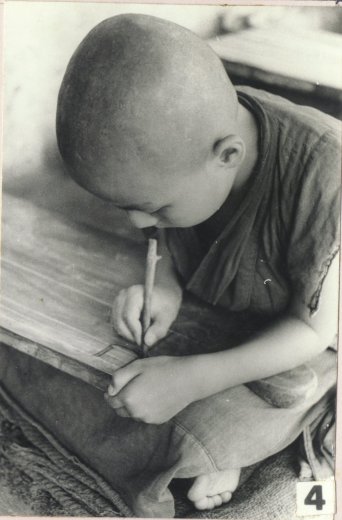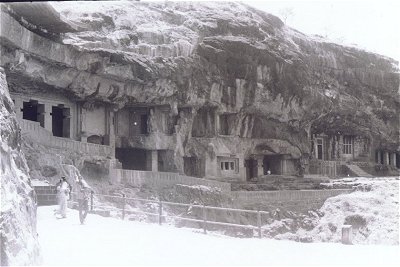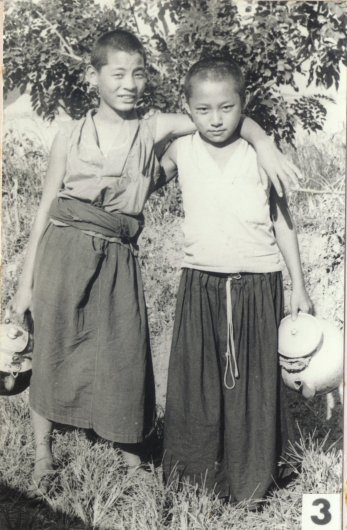Buddhist System of Education
Buddhism flourished in Karnataka in ancient times, along with Vedic religion and Jainism. Ashoka Maurya (274-236 B.C.), the great Indian emperor, may be considered to be the first emperor of Karnataka as well. For a long time, it was believed that the region presently called Karnataka was outside the pale of Mauryan rule and instead formed part of the dharma-vijaya or lands conquered through religious conquests attained by Ashoka, where he subsequently erected edifices with inscriptions expounding the teaching of Buddha, codes of conduct, and welfare-measures. However the chance discovery in 1986 of inscribed edicts and several Mauryan relics at Sannati in the Gulburga district has revealed that the Krishna river basin in northern Karnataka once came under the direct supervision and rule of Ashoka. The Sannati region enjoyed the special status of raja-vishaya (king's division). Mahāmātras or supervisors were given the responsibility of creating cultural awareness, and providing education for the masses. In all the important divisions of his empire, the emperor directly appointed these mahāmātras. Sannati boasted of a mahāmātra1. Ashokan edicts were installed at prominent places that were frequented by people and caravans, and on or near ancient highways, in order to attract the most attention. Sannati in the Mauryan age occupied a crucial position and had cultural links with Vanavasi (Banavasi in North Kanara district), with Sriparvata (presently called Nagarjunakonda, in Andhra Pradesh) and with Sri Lanka. "Sannati," according to some scholars, is the modern name of Suvarnagiri, which is mentioned in Ashokan inscriptions.© K. L. Kamat

Picture 4: Buddhist student practicing writing
Just like Sannati, Banavasi (also called Vanavasi) was another important Buddhist cultural center. According to Mahavamsha, an ancient Ceylonese chronicle, Ashoka sent a monk called Mahadeva to Mahishamandala (modern day Mysore) and the monk Rakshita to Banavasi, in order to propagate Buddha's teachings. Several Buddhist āchāryas under the leadership of Chandragupta proceeded from Banavasi to Sri Lanka to attend the consecration of the great stupa (Buddhist monument) built by king Duttagamini in the 1st century B.C.E. Indications are that by this time Banavasi flourished as an important center of Buddhism. It is frequently referred to in Sinhalese tradition as a seat of learning. Banavasi was closely linked with Nagarjunakonda, which was a resort for Buddhist āchāryas , who helped convert residents of Kashmira, Gandhara, Banavasi and Tamralipti regions to Buddhism. Banavasi, although merely a small town today, represented a very vast region in ancient times, which was collectively called Banavasi-nādu. It was called thus for centuries, under different dynasties that ruled Karnataka. Buddhist relics as late as from the thirteenth century C.E. are found in the region that formed administrative division of Banavasi-nadu.
Buddhist monasteries or vihāras were and still are centers of education; the first mention of a vihāra in Karnataka happens to be in Banavasi. An inscription in the Brahmi script dating back to the third century C.E. indicates that a Chutu princess called Shivaskanda Nagashree donated a vihāra in this location. Hiuen Tsang, the Chinese pilgrim who traveled in south India in about 640 C.E., wrote that Buddhism flourished in Karnataka and that there were many monasteries of both Mahayana and Hinayana sects2.
Buddhist relics are found scattered throughout the state of Karnataka. Besides the six minor rock inscriptions, three each in Raichur and Chitradurga districts, there are idols of Yaksha in Haigund, and fragmentary relics and inscriptions in Babruwada, Divgi, Hiregutti (all in Uttara Kannada district), Koliwada, Dambal (Gadag district), Kundapur, Mulur, Pampalli, Kadri (South Kanara district) and Ballegavi (Shimoga district.) These indicate that there were Buddhist habitations in all these places at one time or another. Perhaps a lack of direct royal patronage made the Buddhist community, by then reduced to a minority, leave capital cities, and take shelter in smaller towns. From existing historical evidence it may be surmised that Buddhism did remain an important sect for nearly fifteen centuries in Karnataka, and that it has left a permanent mark on the native system of education and deserves special study for this reason also. In the initial years of the spread of Buddhist doctrine, itinerant monks carried the message far and wide. They literally lived the instruction, "move on, ye monks, for the welfare of the masses, their happiness and for the sake of kindness towards humanity, keep on moving!" ("chārata bhikkave, chāritām, bahujanahitāya, bahujana sukhāya, lokānu kampaya..."). Those who took the message seriously were determined to provide religious education to the masses, toured every nook and corner of the land, and at some point arrived in Kuntala desha or Karnataka (Konkanapura of Hiuen Tsang), a land of rivers, mountains and the sea.
During the rainy season, the monks had to take shelter in secluded and protected places. They also needed space for meditation, study and discussion. Cave-resorts or layanas thus came into existence, which eventually grew into vihāras or places of rest, where education was also imparted. These layanas (also called lenis) were built by the royalty and the laity alike, in gratitude for the spiritual and moral guidance they received from the monks. The entire region of the Deccan plateau, from the Konkan coast to the Krishna river in the east, and down to the river Tungabhadra in the South, came under the Satavahana rule, after the decline of the Mauryas. This period of more than three hundred years saw the building of rock-cut chetiyas (also called chaityas) or places of worship and smaller layanas for bhikkus (renunciate-monks). These vihāras, chetiyas and layanas provide valuable insight into the educational activities of those times.
All famous guhālayas or cave-resorts such as those of Kanheri, (near Mumbai), Karla and Bhaja near Pune, Ajanta and Ellora and also those of Nasik, were hewn out of rock in order to accommodate numerous monks, student-bhikkus, and also the laity on special occasions. The earlier caves, though spacious, lacked sculptural decoration. But the later ones at Karla, Ajanta and Ellora represent feats of art and engineering as well. At times, they are double storyed and contain prayer halls, meditation centers and hostels - consisting of cubicles for bhikkus - all in the same structure.
The chaitya had the main gate or porch, which led to the stupa or alternatively to an image of Buddha. Usually this area was spacious enough to hold the large teacher-student congregation. A hall was attached to every chaitya, at some places with stone benches and a niche in the wall (for a notice board or a writing board). This hall appeared to have been a classroom. Small cubicles or cells were often seen around the hall, which contained one or two stone bunks, space to store a pair of sandals or clothes, and an alcove for an oil lamp. These might have served as dormitory cells for student bhikkus (as shown in the picture no. 2). The cave-temple schools flourished for centuries as educational centers.
© K. L. Kamat

Three Storied Buddhist University
Ruins of Ellora in Maharashtra
One of the beautifully carved cave-dwellings in Karla was constructed by Bhuta Pala Shetti of Vaijayanti or Banavasi, as declared by an inscription in the Prakrit language on a stone pillar. He may have been one of the many rich merchants who traded with Greece and Rome in the early centuries of the Christian era. The nearby towns of Kalyan and Sopara (now in Maharashtra) known to ancient Greek historians, were international ports, and continued to function as such under Chalukyan and Rashtrakuta times.
The caves at Kanheri, Karla, and Nasik received several grants from the royal and lay patrons in support of education. Irrespective of their personal religious inclinations, the kings of Karnataka patronized Buddhism for centuries, not only at home, but also in distant lands. Hiuen Tsang writes of having stayed in the vihāra at Kapisa (in far-away Afghanistan3), which was built by the Chalukya dynasty of Badami, in the 7th century C.E.! Liberal grants from the Rashtrakuta rulers, Dantidurga and Dhruva II, to the mahāvihāra at Kampilya in Saurashtra (modern-day Gujarat) are mentioned in inscriptions. These rulers had earlier defeated the Maitraka dynasty that ruled the region, but donations continued in the 7th and 8th centuries. Kampilya at the time accommodated 500 bhikkus in its mahāvihāra. Akkadevi, the governor of Banavasi-nadu, is described as practicing religious observances prescribed by the rituals of four deities: Jina, Buddha, Ananta (Vishnu) and Rudra, according to an inscription from1022 C.E.
We see that commoners also were acknowledged as donors and builders of vihāras. For instance, the people of Balligamé built a matha (monastery) in honor of Buddha, along with one each for Hari Hara, Brahma and Jina. Bappur Nagiyakka built a temple for Tara Bhagavati, and Rupabhattayya constructed a vihāra called Jayanti-prabha in memory of his birthplace, Banavasi4. Since vihāras were centers of learning where bhikkus and commoners received instruction, we may safely state that the Buddhist system of education prevailed in Karnataka until the 11th century C.E.
Unlike the age-old oral tradition of learning, wherein attentive listening, memorizing and reproduction were everything, the Buddhist system laid stress on writing and literary education. In the vihāras children were taught the alphabet. Regardless of caste, students were allowed to attend temple-schools at the age of seven. Students in this age group were considered to be ideally suited and receptive enough to learn and obey the guru's instructions.
The academic day in a typical elementary school began with the paying of obeisance to Siddha (Buddha) or the enlightened one. "Siddham namah" (literally, "I bow to the Siddha") became the universal invocation, and survives to this day5. Members of the older generation in India inscribe these words at the top of a letter or other important document. After the ritual obeisance at the start of the day, the alphabet was taught to the students. The letters were printed in a calendar, or alternatively in an arrangement of fifty-two letters a series of twelve blocks, and called bārākhadi (bārā = twelve, khadi = block). This method of reading and writing the alphabet can be found today in Marathi, Kannada and other Indian languages. Hiuen Tsang and the renowned Arab scholar, Alberuni, who referred to it as the siddhamātrikā , (it is prevalent even today) mention this method of learning the alphabet6.
The use of vernacular languages for higher learning also began during Buddhist times. Buddha preached in Magadhi, the spoken language, rather than in Sanskrit , the language of the elite. With the spread of Buddhism , all regional languages gained importance as mediums of instruction. Ashokan inscriptions bear witness that the Prakrit language and the Brahmi script (with local variations) were used throughout the Indian subcontinent, and beyond. The growth of the written word occurred mainly for spreading Buddha's teachings, and also to teach monastic rules to monks. The written language also helped establish rules of good conduct for lay people, through inscriptions on stone - a method ingeniously devised by emperor Ashoka.
After mastering the alphabet, the student was taught grammar, arithmetic, and elements of a skilled profession such as shilpa or sculpture. Principles of mechanical arts, medicine, reasoning (logic), the degrees of religious attainment and the subtle doctrine of karma were taught gradually7. Although the curriculum was originally designed to train Buddhist monks, these principles of education became applicable to lay students as well. The emphasis placed on vocational skills such as sculpting, painting, carpentry, weaving and medicine helped the populace immensely.
With the expansion of religion came the spread of literacy and education. Bigger monasteries appeared near towns and cities, with huge grants from royalty, noblemen and traders. Education became broad-based with the inclusion of comparative religions in the curriculum. Monks arrived from distant lands such as China, Japan and Korea, where Buddhism had already taken root. This is partly why we are able to obtain a vivid description of the life in Indian monasteries such as Nalanda , through the writings of Hiuen Tsang (600-664 C.E.) and Itsing (8th century C.E.). Hiuen Tsang thought that the reason for the high scholarship of Indian Buddhists was due to their relative freedom from worldly needs, and the consequent ability to focus one-pointedly on study. He was very appreciative of liberal grants made by patrons towards the promotion of education and learning.
Karnataka did not have a big university like Nalanda (of northeastern India), but there were more than a thousand vihāras in the land of Pulikeshi, with ten thousand bhikkus, as noted by Hiuen Tsang. All the three important schools of Buddhism , namely Hinayana, Mahayana, and later Vajrayana flourished in Karnataka over the centuries. Although Buddhism slowly declined after the 12th century, the strong educational foundation it left behind continued to thrive. In Jaina and Vedic centers, the same curriculum prevailed at the elementary level, where the medium of instruction remained Kannada.
It is possible that the combination of literary education and vocational training imparted in veerashaiva mathas was similar to the system prevailing in Buddhist vihāras. Emphasis was laid on kāyaka or vocation, as a means of realizing God. 'Kayakave kailāsa" (or "work is worship") was the motto of Basava's teaching. Arts and crafts played a prominent role, as most veerashaiva saints undertook them. Among these saints were weavers, spinners, washermen, and shoemakers. The temple-schools included Sali-mathas, odisuva-mathas and virakta-mathas , which taught spinning, weaving, smithy, agriculture and medicine, in addition to spiritual doctrine. This vocational training provided in the mathas might have helped lessen social and economic differences in the society of those times. This again reminds us of the legacy of the Buddhist system, which preached a casteless society.
Buddhist monks used several artistic forms to propagate religious teaching. Jataka stories - the rebirth stories of Buddha - were represented in sculpture and paintings. Monks excelled in these arts, as evidenced by the cave paintings and sculptures of Ajanta and Ellora, which formed part of greater Karnataka in bygone days.
The original Buddhist educational system was resurfaced in this land in an unexpected way, after several centuries: Tibetans fleeing communist Chinese aggression arrived in India in 1959, in the footsteps of His Holiness, the Dalai Lama, their spiritual leader. Some batches of these refugees were comfortably accommodated in Baylakuppe near Mysore and Mundgod in North Kanara district. Nine batches of refugees were granted four thousand acres of agricultural land in Tattihalli near Mundgod. Although the climate in these southern regions of India was very different from that of the Himalayan region from which they arrived, the hard-working Tibetan community adapted very quickly to its new surroundings.
In Mundgod there are two monasteries dedicated to Buddha Avalokiteshvara, the patron deity of Tibet. In these monasteries, the places of worship, meditation and learning, namely Gomang, Sakya and Sarse, are reminiscent of the ancient vihāra and chaitya prayer halls. They brim with activity, day and night. No fear of bandits or theft pesters them. The atmosphere is serene and quiet. Their chortens resemble pagodas and ancient stupas and are painted in pink and yellow colors, which are considered auspicious. These Tibetan stupas are sometimes dedicated to the memory of departed Lamas. Building these chortens is a continuous process, which is believed to be essential for the welfare of the community. All the residents of the monastery undertake meditation and japa (ritual chanting accompanied by the rosary or the prayer-wheel). Every member of the monastic community is engaged in one constructive activity or the other, including carpentry, gardening, weaving, and scores of other crafts. Youngsters are engaged in bringing water, fetching wood, etc. (see picture no.3 below)
© K. L. Kamat

Picture 3: Buddhist students on way to fetch water
Each family in the community aspires to have at least one child follow the monastic path, by becoming a bhikku or a lāmā (revered one). From a very young age, the chosen ones start living in the monastery , engaging themselves in studying scriptures, reading, writing and meditation, besides mastering different crafts. Prayer halls are beautifully decorated with multi-colored flags and inlay-work in gold and other metals, and also contain elaborately carved wooden pedestals to support statues of Buddha and other deities. The blowing of conches and the beating of drums alert students to times for prayer and study. Reading, writing and arithmetic (the three Rs) predominate in their course of study for young acolytes. Traditionally, students write the Tibetan alphabet on a slate placed on wooden blocks, using black ink and a bamboo pen (see picture no. 4). Sacred writing is copied on birch leaves (bhûrjapatra) as was the practice in ancient vihāras. Monks also recite various scriptures that are appropriate for the specific training they undergo. They learn drawing, painting and sculpting as well. In some ways, the scene in Gomang takes one back two thousand years, when life in the Buddhist vihāras of Karnataka might have been similar!
![]()
References
- M. V. Vishweswara. "Inscriptions at Sannati." Samshodhana, Dr. Chidananda Murthy Felicitation Volume, Bangalore 1991, pp. 723-743.
- Thomas Watters. On Yuan Chwang's Travels in India. Vol. II, London 1904, p. 239.
- Sukumar Dutt. Buddhist Monks and Monasteries of India, London 1962, p. 230, p338.
- Epigraphia Carnatica, Vol. VII, Shikarpur 170.
- B. Seshagiri Rao. Andhra Karnata Jainism, Madras 1922, p. 64.
- Ainslie T. Embree. Alberuni's India, New York 1971, p. 173
- Thomas Watters. On Yuan Chwang's Travels in India. Vol. I, London 1904, pp. 154-155.

